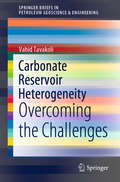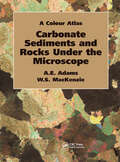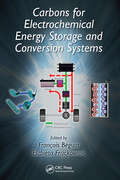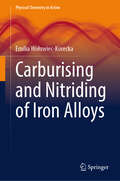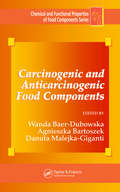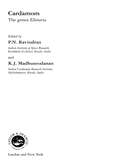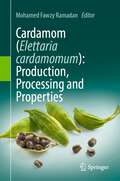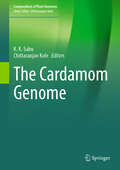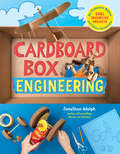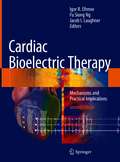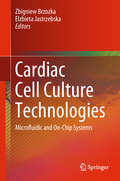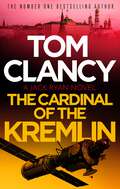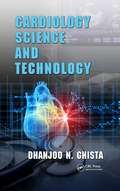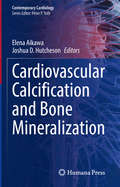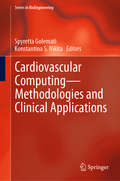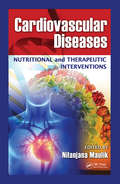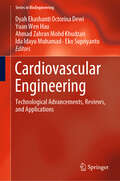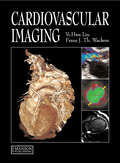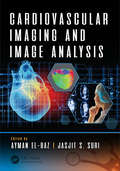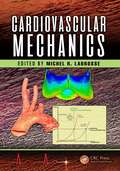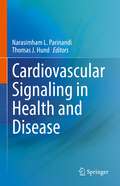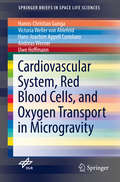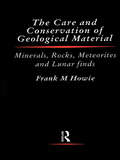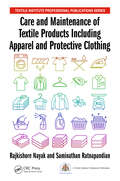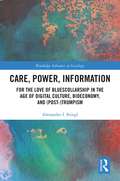- Table View
- List View
Carbonate Reservoir Heterogeneity: Overcoming the Challenges (SpringerBriefs in Petroleum Geoscience & Engineering)
by Vahid TavakoliThis book provides a comprehensive overview of the parameters and factors that cause heterogeneity in carbonate reservoirs, and examines how they interact with one another. It explores the various scales of heterogeneity, how they are caused, and how they can be minimized, as well as how the scales affect each other, providing practical examples in each chapter. The book concludes by discussing the effect of heterogeneity on petrophysical evaluations. As reducing heterogeneity is the only way to obtain accurate carbonate reservoir characteristics at the regional scale, the book offers an important reference guide for all geologists, engineers, and modelers working with subsurface data.
Carbonate Sediments and Rocks Under the Microscope: A Colour Atlas
by Anthony Adams W.S. MacKenzieThis full color atlas illustrates a range of features not attempted in any general textbook and is designed as a laboratory manual to keep beside the microscope, as an aid to identifying grain types and textures in carbonates.
Carbons for Electrochemical Energy Storage and Conversion Systems
by François Béguin Elzbieta FrackowiakAs carbons are widely used in energy storage and conversion systems, there is a rapidly growing need for an updated book that describes their physical, chemical, and electrochemical properties. Edited by those responsible for initiating the most progressive conference on Carbon for Energy Storage and Environment Protection (CESEP), this book undoub
Carburising and Nitriding of Iron Alloys (Physical Chemistry in Action)
by Emilia Wołowiec-KoreckaThis monograph is a comprehensive exploration of the thermochemical treatment of iron alloys, focusing specifically on quenching, carburising, and nitriding. The book introduces the importance of materials engineering in the context of contemporary societal needs and delves into the historical development of thermochemical treatment over the centuries. The global challenges facing thermochemical treatment are also outlined while the three primary development trends identified in the literature at the beginning of the 21st century: reducing thermal deformation in mass production, process modelling, and a multifactorial reduction of treatment costs are also reviewed. Finally, a detailed discussion on the significance of computational methods in advancing thermochemical treatment is included. The book provides a detailed examination of thermochemical treatment processes and their evolution and is a useful tool for graduates, researchers, and professionals working in the area of materials engineering.
Carcinogenic and Anticarcinogenic Food Components (ISSN)
by Wanda Baer-Dubowska Agnieszka Bartoszek Danuta Malejka-GigantiAs the interest in anticarcinogenic food components increases, Carcinogenic and Anticarcinogenic Food Components provides information on cancer-promoting and cancer-preventing food components, indicating their contents in foods, biological activities, possible impact on human cancer risk, and practical implications for dietary recommendations and functional design. This volume concentrates on the effects of diet on human health, rather than on the nutritive aspects of diet, and presents the multidisciplinary character of investigations on chemopreventive as well as carcinogenic properties of food components.
Cardamom: The Genus Elettaria (Medicinal And Aromatic Plants - Industrial Profiles Ser. #Vol. 30)
by P. N. Ravindran K. J. MadhusoodananCardamom otherwise known as Malabar cardamom, true cardamom or small cardamom second only to pepper in its importance during the Renaissance period, is often qualified as the Queen of Spices because of its very pleasant aroma and taste. The Western Ghat forest of the Malabar coast, India, is the center of origin and diversity for cardamom and it mi
Cardamom (Elettaria cardamomum): Production, Processing and Properties
by Mohamed Fawzy RamadanCardamom [Elettaria cardamomum (L.) Maton is recognized for its unique taste and aroma. As the third most expensive spice after saffron and vanilla, Cardamom has been used as a spice and flavoring ingredient in food and is rich in bioactive constituents including minerals, carbohydrates, proteins, lipids, essential oils, terpenoids, flavonoids and carotenoids. Cardamom essential oil (CEO) and other bioactive compounds accumulated in cardamom capsules contribute to their characteristic aroma and utility as a novel food and nutraceutical. CEO from capsules possesses monoterpene constituents such as α-terpineol, 1,8-cineole, α-pinene, linalyl acetate, linalool, and nerolidol as well as the ester of α-terpinyl acetate. Flavonoids, anthocyanins, terpenoids, alkaloids, and other cardamom phenolics have shown high MIC values against Campylobacter species and reduced Bacillus subtilis spore. CEO loses its flavor rapidly upon storing under a normal environment. The change in the aroma or flavor could also cause changes in the constituents of its phytochemicals.Cardamom (Elettaria cardamomum): Production, Processing & Properties aims to create a multidisciplinary forum of discussion on E. cardamomum, emphasizing its botany, ethnobotanical, cultivation, horticultural practices, post-harvest, marketability, phytochemistry, extraction protocols, biochemistry, nutritional value, functionality, ethnomedicinal applications and and processing specifics. The book discusses the botanical distribution, phytochemical constituents, food applications and biological activities of cardamom capsule extracts and essential oil. Also, the text discusses the potential applications of E. cardamomum in food, cosmetics and pharmaceutical products. This book is the first of its kind, a full research work dedicated specifically to cardamom applications and benefits that will be of value for researchers from multiple fields.
The Cardamom Genome (Compendium of Plant Genomes)
by K. K. Sabu Chittaranjan KoleThis book is the first comprehensive compilation of elucidation of the genome of cardamom (Elettaria cardamomum Maton) and its genetic improvement. It includes reviews on the genetic resources, genetics and breeding and in vitro culture in cardamom and molecular characterization of phylogenetic relationship of cardamom of Columbia and Costa Rica. This book presents deliberations on the whole genome sequencing and SSR markers of small cardamom. It also enumerates on the genetics and genomics of biotic stress and host-pathogen interaction, genomics of flavors, and transcriptomics resources and their implications and finally functional regulation of mRNAs in cardamom. Altogether, the book contains about 150 pages over 10 chapters authored by globally reputed experts on the relevant field in this crop. The book is useful to the students, teachers, and scientists in the academia and relevant private companies interested in classical genetics and breeding, molecular genetics, structural genomics, functional genomics, plant pathology and plant physiology of cardamom.
Cardboard Box Engineering: Cool, Inventive Projects for Tinkerers, Makers & Future Scientists
by Jonathan AdolphCardboard is everywhere! For creative kids aged 9 to 14, it&’s the perfect eco-friendly building material, and Cardboard Box Engineering is the perfect guide to get them started on inventive tinkering. A working kaleidoscope, a marble roller coaster, a robotic hand, and a wind-powered tractor with cardboard gears are just some of the ingenious projects developed by Jonathan Adolph, author of the best-selling Mason Jar Science. Working with simple household tools, kids can follow the step-by-step photographic instructions to exercise their design smarts, expand their 3-D thinking, and learn the basics of physics and engineering with activities that have real-life applications.
Cardiac Bioelectric Therapy: Mechanisms and Practical Implications
by Igor R. Efimov Fu Siong Ng Jacob I. LaughnerThe updated and expanded second edition of this book presents a contemporary review of the basic science, engineering technology, and clinical practice of cardiac bioelectric therapy. It covers the rapidly expanding technological development of pacemakers and defibrillators as well as ablative therapy, electrophysiological mapping, and other clinical diagnostic and therapeutic breakthroughs. The book highlights many different aspects of bioelectric therapy, including history, biophysical and computational concepts, basic electrophysiology studies, engineering technology advances, and clinical perspectives.In this revised edition, leading clinical and basic electrophysiologists share their perspectives on the science behind the mechanisms of cardiac arrhythmias; breakthrough technologies for scientific and clinical investigation of heart rhythm disorders; theoretical conceptualization of arrhythmias and treatment using state-of-the-art computational approaches; and novel approaches to treatment of cardiac arrhythmias using implantable devices, percutaneous ablation therapies, machine learning, and other approaches. The Second Edition of Cardiac Bioelectric Therapy is an essential resource for physicians, residents, fellows, and graduate students in clinical cardiac electrophysiology, cardiology, and cardiac surgery as well as researchers, professionals, and students in biomedical, mechanical, and electrical engineering.
Cardiac Cell Culture Technologies: Microfluidic and On-Chip Systems
by Zbigniew Brzozka Elzbieta JastrzebskaThis book provides an introduction to the biological background of heart functioning and analyzes the various materials and technologies used for the development of microfluidic systems dedicated to cell culture, with an emphasis on cardiac cells. The authors describe the characterization of microfluidic systems for cardiac cell culture and center their discussion of the use of stem cell stimulation based on four different types: electrical, biochemical, physical, and mechanical. This book is appropriate for researchers focused on on-chip technologies and heart studies, students in bioengineering and microengineering courses, and a variety of professionals, such as biotechnologists, biomedical engineers, and clinicians working in the cardiac diseases field.
The Cardinal of the Kremlin: An electrifying Jack Ryan thriller that will have your heart racing (Jack Ryan #3)
by Tom Clancy'The best of the Jack Ryan series!' New York TimesThe superpower arms negotiations appear to be making progress. But a US spy satellite reveals that the Soviets are building a massive laser-defence system controlled from an other-worldly array of pillars and domes in the Soviet hills at Dushanbe near the border of war-torn Afghanistan.The Americans need more information. The man to give it is Colonel Mikhail Filitov of the Soviet Union, codename Cardinal, America's highest-placed agent in the Kremlin. But Filitov's cover is about to be betrayed to the KGB, and CIA adviser Jack Ryan must rescue Filitov and bring him to safety . . .
Cardiology Science and Technology
by Dhanjoo N. GhistaCardiology Science and Technology comprehensively deals with the science and biomedical engineering formulations of cardiology. As a textbook, it addresses the teaching, research, and clinical aspects of cardiovascular medical engineering and computational cardiology. The books consists of two sections. The first section deals with left ventricular
Cardiovascular Calcification and Bone Mineralization (Contemporary Cardiology)
by Elena Aikawa Joshua D. HutchesonThe book covers the basic science and clinical aspects of cardiovascular calcification and bone mineralization. Cardiovascular calcification is the leading predictor of cardiovascular morbidity and mortality, with a predictive value more significant than blood lipid levels. The presence of calcific mineral in cardiovascular tissues alters biomechanical performance, increasing workload on the heart and potentiating atherosclerotic plaque rupture and subsequent heart attack and stroke. This book examines the role of calcification in cardiovascular disease covering topics such as calcification in the atherosclerotic plaques and aortic valves arteries and valves, aortic valve replacement, peripheral artery disease, imaging of early calcification and target discovery. In addition, various forms of ectopic calcification as well as mechanisms of bone mineralization are discussed.Cardiovascular Calcification and Bone Mineralization is an essential resource for clinicians, researchers, and other medical professionals in cardiology, pathology, and biomedical engineering.
Cardiovascular Computing—Methodologies and Clinical Applications (Series in BioEngineering)
by Spyretta Golemati Konstantina S. NikitaThis book provides a comprehensive guide to the state-of-the-art in cardiovascular computing and highlights novel directions and challenges in this constantly evolving multidisciplinary field. The topics covered span a wide range of methods and clinical applications of cardiovascular computing, including advanced technologies for the acquisition and analysis of signals and images, cardiovascular informatics, and mathematical and computational modeling.
Cardiovascular Diseases: Nutritional and Therapeutic Interventions
by Nilanjana MaulikWith cardiovascular disease remaining one of the primary causes of morbidity and mortality worldwide, there is a great need to further understand the molecular basis of this disease class and develop new therapeutic or preventative measures. Cardiovascular Diseases: Nutritional and Therapeutic Interventions presents up-to-date information on the pa
Cardiovascular Engineering: Technological Advancements, Reviews, and Applications (Series in BioEngineering)
by Dyah Ekashanti Octorina Dewi Yuan Wen Hau Ahmad Zahran Mohd Khudzari Ida Idayu Muhamad Eko SupriyantoThis book highlights recent technological advances, reviews and applications in the field of cardiovascular engineering, including medical imaging, signal processing and informatics, biomechanics, as well as biomaterials. It discusses the use of biomaterials and 3D printing for tissue-engineered heart valves, and also presents a unique combination of engineering and clinical approaches to solve cardiovascular problems. This book is a valuable resource for students, lecturers and researchers in the field of biomedical engineering.
Cardiovascular Imaging
by Yi-Hwa Liu Frans WackersA host of imaging techniques are available to clinical cardiologists, including nuclear imaging, echocardiography, computerized tomography, and magnetic-resonance imaging. Chamber size, ventricular function, valvular function, coronary anatomy, and myocardial perfusion are among a wide array of cardiac characteristics that can all be assessed noninvasively.Cardiovascular Imaging systematically reviews each of these major techniques and provides clinical data from well-designed research studies. Following a brief overview of non-invasive cardiac imaging and the stress modalities used to detect coronary disease, case-based chapters are devoted to each of the various imaging techniques. The final chapter provides a glimpse of future possibilities, particularly with respect to molecular imaging. The text is illustrated throughout with amply-sized images.Demonstrating the values and limitations of the imaging techniques, the book enables practitioners to determine which test, in which patient population, and for which purpose would be the most appropriate to use.
Cardiovascular Imaging and Image Analysis
by Ayman El-Baz Jasjit S. SuriThis book covers the state-of-the-art approaches for automated non-invasive systems for early cardiovascular disease diagnosis. It includes several prominent imaging modalities such as MRI, CT, and PET technologies. There is a special emphasis placed on automated imaging analysis techniques, which are important to biomedical imaging analysis of the cardiovascular system. Novel 4D based approach is a unique characteristic of this product. This is a comprehensive multi-contributed reference work that will detail the latest developments in spatial, temporal, and functional cardiac imaging. The main aim of this book is to help advance scientific research within the broad field of early detection of cardiovascular disease. This book focuses on major trends and challenges in this area, and it presents work aimed to identify new techniques and their use in biomedical image analysis. Key Features: Includes state-of-the art 4D cardiac image analysis Explores the aspect of automated segmentation of cardiac CT and MR images utilizing both 3D and 4D techniques Provides a novel procedure for improving full-cardiac strain estimation in 3D image appearance characteristics Includes extensive references at the end of each chapter to enhance further study
Cardiovascular Mechanics
by Michel R. LabrosseThe objective of this book is to illustrate in specific detail how cardiovascular mechanics stands as a common pillar supporting such different clinical successes as drugs for high blood pressure, prosthetic heart valves and coronary artery bypass grafting, among others. This information is conveyed through a comprehensive treatment of the overarching principles and theories that are behind mechanobiological processes, aortic and arterial mechanics, atherosclerosis, blood and microcirculation, hear valve mechanics, as well as medical devices and drugs. Examines all major theoretical and practical aspects of mechanical forces related to the cardiovascular system. Discusses a unique coverage of mechanical changes related to an aging cardiovascular system. Provides an overview of experimental methods in cardiovascular mechanics. Written by world-class researchers from Canada, the US and EU. Extensive references are provided at the end of each chapter to enhance further study. Michel R. Labrosse is the founder of the Cardiovascular Mechanics Laboratory at the University of Ottawa, where he is a full professor within the Department of Mechanical Engineering. He has been an active researcher in academia along with being heavily associated with the University of Ottawa Heart Institute. He has authored or co-authored over 90 refereed communications, and supervised or co-supervised over 40 graduate students and post-docs.
Cardiovascular Signaling in Health and Disease
by Narasimham L. Parinandi Thomas J. HundThis contributed volume focuses on cardiovascular diseases (CVDs), and explores the ways in which signaling mechanisms at the biochemical, molecular, and cellular levels in the blood vessels (vascular) and heart contribute to the underlying causes of development and progression of the CVDs. This volume covers unique topics such as oxidant signaling in vascular and heart diseases and health, cytoskeletal signaling in vascular health and disease, phospholipase signaling in CVDs, lipid signaling in vascular and myocardial health and diseases, and drug discovery in cellular signaling for cardiovascular diseases.This book assembles the most important discoveries made by leaders on the cellular signaling mechanisms operating behind the development and progression of life-threatening CVDs. It is an extremely useful resource for the investigators in the field of CVDs, and opens the discussion for further discovery of efficient management and effective treatment of the CVDs.
Cardiovascular System, Red Blood Cells, and Oxygen Transport in Microgravity (SpringerBriefs in Space Life Sciences)
by Hanns-Christian Gunga Victoria Weller von Ahlefeld Hans-Joachim Appell Coriolano Andreas Werner Uwe HoffmannThis book comprehensively describes the physiological changes and consequences that occur in humans during spaceflight. It specifically presents the adaptations of the cardiovascular and the respiratory system. Specific changes occurring after 10, 20 or more days in space are depicted. Furthermore, the book explains various effective countermeasures that are required upon return of the astronauts to Earth. The book is a must-have for all biomedical and clinical researchers in the field of cardiovascular biology and respiration, and a fascinating reading for all interested laymen, who wish to understand a bit more about spaceflight research and technology.
Care and Conservation of Geological Material (Conservation And Museology Ser.)
by Frank HowieThis is the first book to specifically address the preservation of an increasingly important group of materials. Techniques for processing minerals and rocks in the field and laboratory are outlined as well as the effects of treatments on specimens. Readership: Professional museum staff, curators and conservators, scientists and technicians; Students of mineralogy, private collectors.
Care and Maintenance of Textile Products Including Apparel and Protective Clothing (Textile Institute Professional Publications)
by Rajkishore Nayak Saminathan RatnapandianProper care and maintenance of textile materials is essential in prolonging their durability and appearance. This books describes methods of care and maintenance for textile products, focusing on types of laundering and dry-cleaning processes, chemicals, and equipment, while considering the environmental impacts of these procedures and green cleaning approaches. It details care labelling of garments, including electronic care labelling and instructions for different specialty textiles. Factors such as pilling, abrasion, snagging, color fading, and dimensional change are discussed. This book also emphasizes care and maintenance of textiles used for protection from fire, bullets, cold weather, and chemicals.
Care, Power, Information: For the Love of BluesCollarship in the Age of Digital Culture, Bioeconomy, and (Post-)Trumpism (Routledge Advances in Sociology)
by Alexander I. StinglThis book is a critique and provincialization of Western social science and Global Northern academia, by the author of The Digital Coloniality of Power. It exposes shared colonial and extractive rationalities and histories of research, higher education, digitalization, and bioeconomy while proposing in the idea of BluesCollarship, a sketch for an alternative culture of worlding and commoning knowledge work and for making care matter in research and higher education. In a discourse analysis and provincialization of research and higher education, a tradition of elitist White-Collaredness in academia and in the social sciences, in particular, is criticized, and an alternative attitude towards the production, transfer, and use of knowledge – BluesCollarship – is proposed. The latter is rooted in a different idea of what "infrastructure" is, and in practices of decoloniality. Noting the current political climate of propaganda and populism, the persistence of social inequalities as well as of racism and misogyny, it is proposed that how people give warrant for knowledge claims should be reviewed under different terms. A coherent theme is that there is a genealogical root for current neo-extractive and neo-colonial rationalities in the Athenian idea of oikos, which conflates family, household, and property. In taking a distinctly writerly approach – rather than giving ready-made answers – the book aims at permanently provoking readers at every turn to think further, as well as before-and-beyond what is written, but to do so in thinking together with Others. Thus the book addresses scholars and students from across the social sciences who seek challenges to established ways of thinking in academia without simply replacing one canon for another. This book is for those who think of themselves as knowledge and culture laborers in this age of precarization, who seek to replace the university and cognitive capitalism with a pluriversity and an infrastructure built on knowledge and culture as fundamental values.
